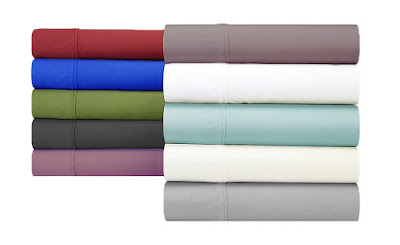The quality of
Bed Sheets is often conveyed by the thread count—the number of threads per square inch of material. In general, the higher the thread count, the softer the sheet, but the weave and type of thread may affect the "hand" of the material so that a sheet with a lower thread count may actually be softer than one with a higher count. Yarn quality also plays a part in the look and feel of sheets, as finer yarns tend to create a finer sheet fabric. The ply also plays a role in how heavy the sheet feels. Ply represents how many fibers are twisted together as the sheet is being created. A 2 ply 300 thread count sheet will feel heavier than a single ply 600 thread count sheet. "The heavier ply generally means a more durable sheet as well."
Materials used in Bed Sheets
The most common constructions are muslin, percale, sateen, flannel, and knitted jersey. In a plain weave the warp and weft cross each other one at a time, and sateen, has multiple threads (usually three or four) over, and one under. Thread Count refers to the number of horizontal and vertical threads in one square inch of fabric. Thread count in
Bed Sheets can range from 60 to 800. The most often purchased sheets are sheets that range from 180 to 350 thread count. The higher the thread count, the softer the sheets feel.
Different Fabrics used in Bed Sheet Different fabrics require different thread counts to achieve their finishes. For example, linen is a very high quality fabric, but can have a thread count as low as 50. Its thread count is only low because of the way that the fabric is woven to provide its looser weave and finish. It’s best to think of thread count as a guide to the type of fabric and to be mindful that you cannot judge a fabric based purely upon this measure.
How can you choose quality sheet sets?
Is Thread Count That Important? Yes or No
Thread count often used as the barometer of a
Bed Sheets Online smoothness and durability. However, this measurement—which should refer to the number of threads woven into a square inch of fabric—isn’t always reliable. High thread count is a factor, but the type of cotton can be more significant.
What’s The Best-Quality Cotton?
Top-of-the-line is 100 percent Egyptian cotton. Second best is 100 percent pima cotton, also known by the trademarked name Supima. If a label says simply, “100 percent cotton,” assume that it is American upland cotton, a rougher, less expensive variety. Egyptian cotton’s long fibers produce sheets that are thin and sumptuous yet extremely strong and long-lasting. (The shorter fibers of upland cotton, by contrast, can poke out of the weave, leading to a coarser, weaker fabric.) Pima cotton is also soft and less likely to pill than upland cotton. You can find a good queen set made of Pima for less than $200. If you want the best, you will invest about $500 in an Egyptian-cotton set in percale or sateen—both clean, classic weaves. (See this round up of luxury sheets for our favorite picks.

No comments:
Post a Comment